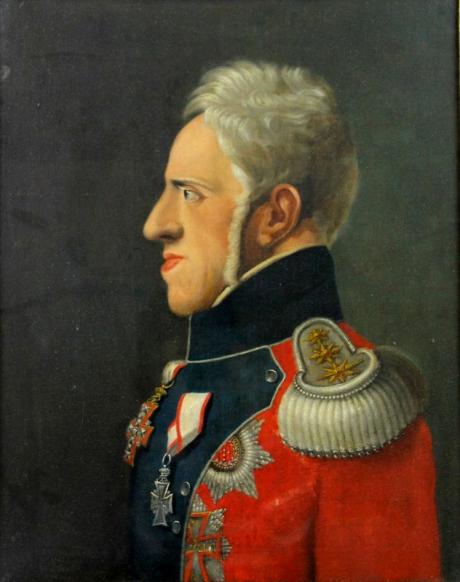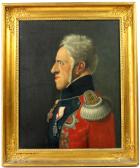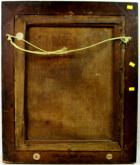framed, 83 by 53cm
Private Lincolnshire Estate of a Danish Family
Frederick VI 1768 – 1839 was King of Denmark from 13 March 1808 to 3 December 1839 and King of Norway from 13 March 1808 to 7 February 1814. From 1784 until his accession, he served as regent during his father's mental illness and was referred to as the "Crown Prince Regent" (kronprinsregent). For his motto he chose God and the just cause (Danish: Gud og den retfærdige sag) and since the time of his reign, succeeding Danish monarchs have also chosen mottos in the Danish language rather than the formerly customary Latin.
Frederick was born at Christiansborg Palace in Copenhagen. Frederick belonged to the House of Oldenburg. His parents were King Christian VII and Caroline Matilda of Great Britain. He was born after 15 months of marriage, a day before his father's 19th birthday, when his mother was just 16. As the eldest son of the ruling king, he automatically became crown prince at birth. On 30 January of the same year, he was baptised at Christiansborg Palace by Ludvig Harboe, Bishop of Zealand. His godparents were King Christian VII (his father), the dowager queen Juliana Maria (his step-grandmother) and his half-uncle, Hereditary Prince Frederick (Arveprins Frederik).
His father suffered from serious psychological problems, including suspected schizophreniaexpressed by catatonic periods which resulted in the king ceding power to his doctor, Johann Friedrich Struensee. From 1770 to 1772, Struensee was de facto regent and lover of Caroline Matilda, Frederick's mother. Both were ideologically influenced by Enlightenment thinkers such as Voltaire and Jean Jacques Rousseau. While Struensee was in power, young Frederick was raised at Hirschholm Palace following the educational approach advocated by Rousseau in his famous work Émile. Instead of receiving direct instruction, Frederick was expected to learn everything through his own efforts through playing with two commoner boys as per Struensee's instructions.
On 8 January 1772, after the revolt against Struensee, Frederick's 18-year-old half-uncle Hereditary Prince Frederick was made regent. The real power, however, was held by Hereditary Prince Frederick's mother (Crown Prince Frederick's step-grandmother), Queen Dowager Juliana Maria, aided by Ove Høegh-Guldberg. Finally, on 14 April 1784, the crown prince Frederick was declared of legal majority; he proceeded to seize and exercise the full powers of the regency, dismissing the ministers loyal to the Queen Dowager. It is said that during the coup, he engaged in a fistfight with his half-uncle over the regency. He continued as regent of Denmark under his father's name until the latter's death in 1808.
During the regency, Frederick instituted widespread liberal reforms with the assistance of Chief Minister Andreas Peter Bernstorff, including the abolition of serfdom in 1788. Crises encountered during his reign include disagreement with the British over neutral shipping. This resulted in two British attacks on Copenhagen, the Battle of Copenhagen of 1801 and the Battle of Copenhagen of 1807. The conflict continued in the Gunboat War between Denmark-Norway and the United Kingdom, which lasted until the Treaty of Kiel in 1814.
There was speculation that he was to marry a Prussian princess, a choice supported by his step-grandmother Juliana Maria and her brother-in-law Frederick the Great. To show his independence from advisors, he personally selected his first-cousin Marie Sophie of Hesse-Kassel, a member of a German family with close marriage links with the royal families of both Denmark and Great Britain. They married in Gottorp on 31 July 1790 and had eight children. Their eldest daughter, Princess Caroline married her father’s first cousin, Ferdinand, Hereditary Prince of Denmark. The youngest, Princess Wilhelmine, became the wife of the future Frederick VII of Denmark. None of Frederick VI's sons survived infancy and when he died, he was succeeded by his half-cousin Christian VIII of Denmark, the son of his half-uncle Prince Frederick.
Frederick became King of Denmark-Norway on 13 March 1808. When the throne of Sweden seemed likely to become vacant in 1809, Frederick was interested in being elected there as well. Frederick actually was the first monarch of Denmark and Norway to descend from Gustav I of Sweden, who had secured Sweden's independence in 1520s after the period of the Kalmar Union with other Scandinavian countries. However, Frederick's brother-in-law, Prince Christian Augustus of Augustenborg, was first elected to the throne of Sweden, followed by the French Marshal Bernadotte.
During the Napoleonic Wars, he tried to maintain neutrality, however after the British bombardment of Copenhagen, he was forced to ally Denmark-Norway with Napoleon. After the French defeat in Russia in 1812, the Allies again asked him to change sides but he refused. Many Danish historians portray the king as stubborn, incompetent, and motivated by a misconceived loyalty towards Napoleon. However some historians in recent years have provided a different interpretation that sheds a better light on the king. He stayed with Napoleon in order to protect the exposed situation of Norway, which was dependent on grain imports and had become the target of Swedish territorial ambitions. He expected the wars would end with a great international conference in which Napoleon would have a major voice, and would help protect Denmark's interests, especially in Norway.
After the French defeat in the Napoleonic Wars in 1814 and the loss of Norway, Frederick VI carried through an authoritarian and reactionary course, giving up the liberal ideas of his years as a prince regent. Censorship and suppression of all opposition together with the poor state of the country's economy made this period of his reign somewhat gloomy, though the king himself in general maintained his position of a well-meaning autocrat. From the 1830s the economic depression was eased a bit and from 1834 the king reluctantly accepted a small democratic innovation by the creation of the Assemblies of the Estate (purely consultative regional assemblies); this had the unintended result of later exacerbating relations between Danes and Germans in Schleswig, whose regional assembly became a forum for constant bickering between the two national groups.
Frederick VI was known as a patron of astronomy and in 1832 offered gold medal prizes to anyone who discovered a comet using a telescope. His successors continued this until 1850. The prize was terminated in the aftermath of the First War of Schleswig. After the discovery of the Haraldskær Woman in a peat bog in Jutland in the year 1835, Frederick VI ordered a royal interment in an elaborately carved sarcophagus for the Iron Age mummy, decreeing it to be the body of Queen Gunnhild. Later this identification proved incorrect, but the action suited his political agenda at the time.
Frederick VI died at the age of 71 at Amalienborg Palace and was buried in Frederick V's chapel in Roskilde Cathedral. Frederick reigned over Denmark for a total of 55 years; 24 years as crown prince regent and 31 years as king. He was the 894th Knight of the Order of the Golden Fleece in Spain and the 654th Knight of the Order of the Garter in 1822. The Royal Frederick University (now University of Oslo) in Oslo was named in his honour.
As Frederick VI had no surviving sons to succeed him (only two daughters), he was succeeded on the throne of Denmark by his half-first cousin Christian, who was his father's half-brother's son.
Frederick VI and his wife Marie of Hesse-Kassel were the parents of eight children, but six of them died in infancy. Only two daughters grew to adulthood, and incidentally, both of them remained childless, meaning that Frederick VI and his wife had no grandchildren at all. Their children were:
- Christian (Copenhagen, 22 September 1791 – Copenhagen, 23 September 1791)
- Marie Louise (Copenhagen, 19 November 1792 – Frederiksborg, 12 October 1793)
- Caroline (Copenhagen, 28 October 1793 – Copenhagen, 31 March 1881), married to her father's first cousin Frederick Ferdinand of Denmark, (d. 1863). Childless.
- Louise (Copenhagen, 21 August 1795 – Copenhagen, 7 December 1795)
- Christian (Copenhagen, 1 September 1797 – Copenhagen, 5 September 1797)
- Juliana Louise (Copenhagen, 12 February 1802 – Copenhagen, 23 February 1802)
- Frederikke Marie (3 June 1805 – 14 July 1805)
- Vilhelmine Marie (Kiel, 18 January 1808 – Glücksburg, 30 May 1891), married twice; firstly her second cousin Frederick (the future Frederick VII of Denmark), but they divorced, and she married secondly Karl, Duke of Schleswig-Holstein-Sonderburg-Glücksburg, who was eldest brother of the future Christian IX of Denmark. Both her marriages were childless.
By his mistress Frederikke Dannemand (Bente Mortensdatter Andersen (Rafsted)),King Frederick VI had the following children:
- Lovisa, Countess of Dannemand (16 April 1810 – 28 December 1888), married in 1836 Wilhelm von Zachariae (6 June 1807 – 16 August 1871), and had issue
- Karoline, Countess of Dannemand (1812–1844), married in 1837 Adolf Frederik Schack von Brockdorff (Vejle, 7 February 1810 – 18 October 1859), and had issue
- Frederik, Count of Dannemand (20 July 1813 – 12 March 1888), married firstly in 1840 Franziska von Scholten (1820–44), without issue, married secondly in 1845 Lovisa Grefvinde Schulin (1815–1884), without issue, and married thirdly in 1884 Wilhelmina Laursen (1840–1886), without issue
- Waldemar, Count of Dannemand (6 June 1819 – 4 March 1835)
As the Prince Regent, Frederick is a leading character in the comic opera "His Excellency" by Gilbert and Sullivan.
Christoffer Wilhelm Eckersberg (2 January 1783 – 22 July 1853) was a Danish painter. He was born in Blåkrog in the Duchy of Schleswig (now in Aabenraa Municipality, in the southern part of Jutland in Denmark), to Henrik Vilhelm Eckersberg, painter and carpenter, and Ingeborg Nielsdatter. He went on to lay the foundation for the period of art known as the Golden Age of Danish Painting, and is referred to as the Father of Danish painting.
In 1786 his family moved to Blans, a village near the picturesque Alssund, where he enjoyed drawing pictures of the surrounding countryside, and taking sailing tours in his father's boat. After confirmation he began his training as a painter under church- and portrait painter, Jes Jessen of Aabenraa (1797–1800). He continued his training at 17 years of age under Josiah Jacob Jessen in Flensborg, where he became an apprentice in May 1800. He, however, had his sights set on being accepted at the Royal Danish Academy of Art (Det Kongelige Danske Kunstakademi) in Copenhagen.
Still under apprenticeship he produced proficient drawings and paintings. Having amassed some money, including financial support from local well-wishers, he arrived at Copenhagen's Tollbooth on 23 May 1803. He was accepted into the Academy without payment in 1803 where he studied with Nikolaj Abraham Abildgaard, among others.
He made good progress, painting historical paintings, portraits and landscapes. However, friction between him and Abildgaard impeded his advancement, and he did not win the Academy's big gold medal until 1809, after Abildgaard's death. He also worked to earn living money as a hand laborer, and he made drawings for copperplate etchings.
Although he received promise of a travel stipend in conjunction with the gold medal, the actual funds would not be made available until 1812. On 1 July 1810, he married E. Christine Rebecca Hyssing against his wishes, in order to 'legitimize' a son, Erling Carl Vilhelm Eckersberg, that was born to her. His son, Erling, eventually followed in his father's footsteps with an Academy education, and a career as a copperplate engraver.
Eager to travel, not only on account of his desire to stretch his artistic skills and knowledge, but also in order to escape the reality of this marriage, he made other arrangements for the financial support needed that would allow him to travel. On 3 July, a few days after the wedding, he began his travels out of the country. Along with Tønnes Christian Bruun de Neergaard, writer, enthusiastic art lover and financial supporter, he made his way over Germany to Paris. Here he studied under neoclassicist Jacques-Louis David from 1811 to 1812. He improved his skills in painting the human form, and followed his teacher's admonition to paint after Nature and the Antique in order to find Truth. It was here that he developed a lifelong friendship with Paris roommate, fellow artist Jens Peter Møller, and with engraver Johan Frederik Clemens, Jens Juel's collaborator.
After two years he traveled further via Florence to Rome where he continued his studies between 1813-1816. He worked on improving his skills as a history painter, and enjoyed painting smaller studies of the local life and area. He lived there three years among a store group of artists, with Bertel Thorvaldsen as the cultural head. Eckersberg and Thorvaldsen developed a close lasting relationship, and the master served the younger Eckersberg as both loyal friend and advisor. Eckersberg painted one of his best portraits, a portrait of Thorvaldsen, in Rome 1814, which was donated to the Academy of Art. Life in Rome agreed with him, and he was greatly affected by the bright southern light he experienced there. He produced a large body of work during those years, including a number of exceptional landscape studies.
His divorce from Hyssing was finalized during his stay out of the country, and on 2 August 1816 he had returned to Denmark.
Shortly after his return to Denmark he arranged for his admission into the Academy, and received as the subject of his admissions painting the Norse legend, the Death of Baldur. On 8 February 1817 he wed Elisabeth Cathrine Julie Juel, daughter of Jens Juel, portrait painter and professor at the Academy. They had two sons and four daughters before her death in 1827.
He was admitted as member of the Academy in October 1817, and was named professor at the Academy in 1818 having acceded to the vacant professorship caused by the death of Nikolaj Abraham Abildgaard in 1809. The Academy had waited to fill the position until Eckersberg had returned to Denmark from his student travels, while delaying the attempts by Abildgaard's disciple, Christian Fædder Høyer, from Christian Gotlieb Kratzenstein-Stub, and from J. L. Lund to seek the same position. Finally the Academy awarded the position not only to Eckersberg, but also to Lund.
A year after the death of his wife Elisabeth in 1827, he married her sister Susanne Henriette Emilie Juel, with whom he also had several children.
He was director of the Academy from 1827 to 1829. His eyesight failed him in later life and he had to give up painting. He died in Copenhagen of cholera on 22 July 1853 during the great epidemic. He is buried in Copenhagen's Assistens Cemetery.
He was commissioned to do a number of historical paintings for Christiansborg Palace, as well as altarpieces. His best known works are portraits of the Copenhagen middle class, such as the "Nathanson family picture" (Det Nathansonske Familiebillede), 1818, and the official portrait of Frederick VI(Frederik VI). In spite of his abilities in this genre, his career in portraiture was short-lived, due to the competition he received from then popular Christian Albrecht Jensen.
Marine paintings were another genre he developed with great interest. He had a passion for ships, and sailed around the Skagerrak, the Kattegat, the North Sea, and as far as the English Channel at the age of 56. The experience of sailing out on the open seas gave new dimension to his marine paintings, which until that point tended to be calm depictions. Now there was more attention given to movement and to waves.

The Admiralty in 1819 had granted him free access to the Copenhagen Naval Station (Holmen), thus giving him occasion to view the many ships – a favorite motive in his paintings. During summer, the sailors would practice swimming here – of course all naked. This gave Eckersberg a unique opportunity to watch men in a state of complete undress and to make an artistic evaluation of their physical build. He could thus here select the models whom he needed for his paintings with motives from Greek or Roman antiquity.
But his biggest contribution to painting was through his professorship at the Academy. He revitalized teaching by taking students out into the field, where they were challenged to do studies from nature. In this way it was he who introduced direct study from nature into Danish art. He also encouraged his students to develop their individual strengths, thus creating unique styles. He developed an increasing interest in perspective on account of his marine paintings. He wrote a dissertation on the subject called "Linear perspective used in the art of painting" (Linearperspektiven, anvendt paa Malerkunsten), 1841, and taught classes on the subject at the Academy. He made a small number of etchings that combine daily life observations with classical, harmonious principles of composition. This led the way to the characteristic manner in which Golden Age painters portrayed common, everyday life.
There is a self-portrait from 1803, a bust of him by Thorvaldsen from 1816 and a portrait by Marstrand from 1836.





